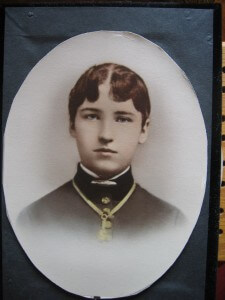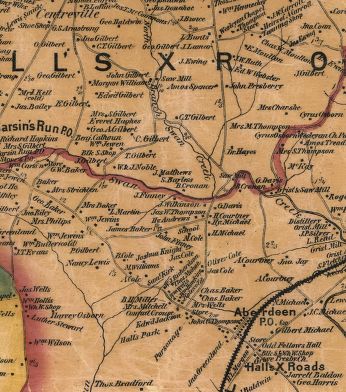This post is a continuation of a series chronicling the relocation of my family cemetery, including my 4th Great Grandparents James Cole and Elizabeth Gilbert, in Aberdeen, Maryland in 2010. Click here to read Part I and Part II.

Charles Darwin and his son, William.
Today, many consider being inbred as more of a joke than a reality. It implies you grew up in the country, perhaps in often maligned West Virginia. But when families stay generation after generation in one area out of which few people move to new territories, inbreeding happens. Charles Darwin and his wife, Emma Wedgewood, are probably the most famous inbred couple. Darwin himself was among the first to scientifically investigate inbreeding, and acknowledged that marrying his first cousin could be responsible for the frequent illness and the deaths of three of their children. This is examined in this article from Bioscience by Berra, Alvarez, and Ceballos.

Addie Louise Cole, granddaughter of James and Elizabeth Gilbert Cole. This portrait was probably taken around the time of her marriage in 1886.
After the exhumation, the Cole family remains traveled to Gibb Archaelogical Consulting’s laboratory for cleaning. During this time, I researched the Coles and thought about the identities of the additional remains. You won’t be surprised when I tell you that James Cole and Elizabeth Gilbert were related. Unfortunately, they shared the DNA of not two, but three siblings. James Cole’s father and Elizabeth’s paternal grandfather and maternal grandfather shared the same parents. Undoubtedly, this isn’t the only case within our family, which has stuck close to Harford County for nearly 400 years.

Martenet Map of Harford County, MD, 1878. Library of Congress. Note the Cole family properties just to the west of Aberdeen. The Gilberts are visible just below the large “LLS X RO” that spells out the Halls Cross Roads area, toward the top of the image.
When you look at a mid-nineteenth century map, you can see that the families’ farms were close to each other. James Cole’s grandfather Thomas purchased the land on Paradise Road in 1757. Gilbert Road, where the Gilbert family farms were located, is not two miles away. As our project to relocate the Coles continued, I found I was related to not only to both genealogists, but also the funeral director. We don’t know anything about the health of James and Elizabeth’s children. We do know that the additional burials held a young woman, an infant, a six year old girl, and an eleven year old. Did inbreeding result in a higher rate of disease and mortality? One British paper notes the link between consanguinity and higher infection rates of tuberculosis in modern Gambia. TB was certainly a health issue in 19th century America, but was not as common in rural areas as it was in cities. This article also suggests that many effects from inbreeding are masked by modern medicine.
Dr. V and I applied for a marriage license in Harford County in December 2011. You may still marry your first cousin in the state of Maryland.
Click here to read the final installment of Digging Up My Ancestors – including a trip to visit Doug Owsley at the National Museum of Natural History, Smithsonian Institution.

This is a fascinating series, Becky.
As an adopted kid growing up, there was often a fantasy/fascination with the idea that I would meet and marry a cousin or sibling without knowing it. I remember being told that before you get married, you get blood tested, which could make or break the marriage.
This didn’t happen when I married Tina. But it stuck in my noggin as fact growing up.
It didn’t prevent me from thinking I’d inadvertently marry a cousin.
Anyway, keep up the great work. Glad to know I could still marry a cousin if I moved to Maryland. 🙂
Hi Jeremy –
Thanks for the compliments. Actually, just a bit of clarification about the marriage blood test: it was to determine if either the bride or groom was infected with syphillis. Syphillis causes blindness in newborns, but couples might not know they had it. If it was discovered at marriage, it could be treated prior to the couple having children.
The whole cemetery thing has been quite a journey. Before I got into genealogy, we didn’t have much of a family story. That is still the case for a lot of families that have Eastern European roots. My luck is that my families are rooted in a lot of early American immigrants, so the documentation is much easier to find. So many people enjoy knowing their family’s past, I wish they could have it as easy. Today, if you want to figure out if you are cousins, DNA tests require only a few cheek swabs.
This is a great correction. Thanks!
You know, I probably knew that my 10-year-old self was wrong at some point, but my mind took me back to the logic it had come up with back in the day. Or the mis-understanding. Whatever.
I say that, because I remember that Tina explained this in another way that — since we had been together for so many years — her annual checkups would determine whether or not I might have something we should both know about.
I love working through my mind’s feeble fallacies.
[…] here and here for the next installments. Share this:Share This entry was posted in Uncategorized and […]
[…] Digging Up My Ancestors – Inbred […]
[…] Digging Up My Ancestors – Inbred […]